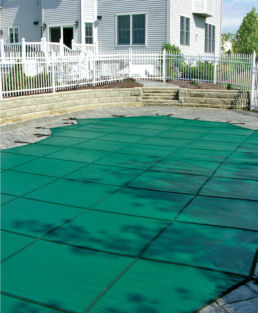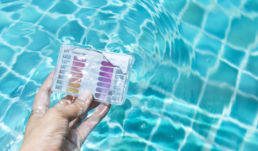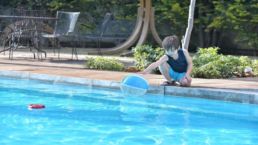Closing Time. This pool won't be open 'til sun or heat come
Sadly, it’s that time again. The temperature is beginning to drop and it’s time to close your pool for the season. If you couldn’t make it to our pool school, we’ve got you covered. The winter ❄️ can be really brutal in upstate NY thats why it is important not to miss a single thing when closing a pool. Here are a few major things Tarson Pools service team takes care of to ensure you get the most out of your pool for the years to come ☀️!
1) Vacuum and Test 💨
The cleaner your pool is when it’s closed, the cleaner it will be when it reopens. Leaving debris and leaves in your pool increases the risk of staining and results in a higher demand for chemicals, so be thorough. Check your water chemistry to ensure it is balanced. We can do it for free here at Tarson in 5 minutes. Doing this will optimize your water balance and make sure you are getting the full potential out of your chemicals.
*If your water is green or discolored, address this before closing your pool.
2) Add Winter Chemicals 🧪
Once the water is tested and balanced, add your winter chemicals as directed. In most cases, the pump should be on. DO NOT add the chemicals into the skimmer. Allow the chemicals to circulate for 2-4 hours before continuing the process.
3) Remove Hardware 🔧
Remove all ladders, toys, diving boards, etc. Reduce wear by placing them in a dry, safe environment so you can enjoy them next season.
4) Drop the Water Level
Change the valve in front of your pump to select the Port 2 setting (the main suction line) and then set your filter to the drain (waste) position. Drain the pool water level 2-4 inches below the bottom of the skimmer.
* If you choose not to drain the pool water level, use a Blowout Extension. It allows you to reduce the force taken by the skimmer when the water freezes.
5) Filtration and Circulation Removal 🔁
Disconnect the filter, pump and heater from their lines and pull the plugs so they can drain. Store the pump indoors and use a Pump Protector to prevent seals from going bad. DO NOT place the sand filter indoors. The sand filter often weight hundreds of pounds. If the sand in the filter shifts it could result in the internals of the filter breaking. DE filters should be cleaned and acid washed before being stored indoors.
6) Blow Out Lines
Select the Port 1 section on the valve to blow out the skimmer line. Using a blower or shop-vac, blow into the valve to push all of the water out of the skimmer lines and return lines. The air will come out of the closest return line first, so plug the line with a 1.5” winter plug then move on to the next. Now that all of the lines are blown out, add nontoxic antifreeze. Use a minimum of 1/2 gallon for every line. For the main drain, which cannot be blown out, use a full gallon of antifreeze.
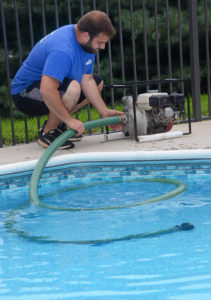 7) Cover Pool
7) Cover Pool
Place the cover over your pool so that it comfortably fits flat on the water. You don’t want your cover to be tight or strained because this may lead to tearing. Place the water bags inside of the designated straps (on inground pools) to weigh down the cover. Fill the water bags half way to leave room for expansion. Place them end to end to avoid wind moving the cover. For extra weight, spray an inch or two of water on the cover.
Let's Explore the History of Chlorine in Pools
For the last hundred years or so, chlorine (in one form or another) has been the go-to option for pool and spa sanitation. But, have you ever wondered why or how? Over this series of posts surrounding the history of chlorine and its use in pools we're going to dive into how chlorine became the de-facto choice for water treatment, explore its role in the rise of the swimming pool, and offer some insight on newer technologies that can help to ween our dependence, and exposure to chlorine.
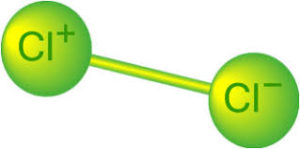
While there's plenty of evidence to show that the Ancient Romans and Greeks were prolific users of "public baths" (early precursors to the swimming pool), for much of western history, bathing was performed only infrequently and very few people even knew how to swim. In the nineteenth century, British enjoyed public baths in India and Japan and brought the modern concept of the swimming pool back home to England. Prior to the use of chlorine, water wasn't really "treated" at all. It was filtered through large sand filters and changed often as it became foul. In 1894, however, it was first suggested to use chlorine to disinfect water to make it "germ-free", and following a serious outbreak of typhoid fever caused by a faulty sand filter in England in 1905, chlorination became the norm. The practice made its way to the US via New Jersey's Boonton Reservoir, in 1908. By the mid-1900's waterworks engineers had mastered the use of chlorine and filtration, and educators and health professionals appreciated the value of swimming for physical fitness. All of the elements of the "modern" swimming pool were in place, and in 1910 Brown University's 70,000-gallon Colgate Hoyt Pool was chlorinated by graduate student John Wymond Miller Bunker and became the first pool to use chlorination as its primary method of disinfection. He published his findings in a paper called "Hygenie of the Swimming Pool" in the American Journal of Public Hygiene, Bunker applied hyperchlorite of lime (calcium hypochlorite) to 2L of pool water at a concentration of 1 ppm. According to the New York Times, the pool remained sterile for four days.

Chlorine kills bacteria though a fairly simple chemical reaction. The liquid chlorine solution you pour into the water (sodium hypochlorite) breaks down into many different chemicals, including hypochlorous acid (HOCl) and hypochlorite ion (OCl-). Both kill microorganisms and bacteria by attacking the lipids in the cell walls and destroying the enzymes and structures inside the cell, rendering them oxidized and harmless. Once the HOCl and OCl- are done cleaning the pool, they either combine with another chemical, such as ammonia, or are broken down into single atoms where they pose little to no health risk to us.
While there's more to "dive into" on the science behind how we keep your water safe and clean, keep posted for more posts as we explore pool and spa water treatment.
Remember your pool safety this summer!
Pool season is finally here! With it comes a chance to revisit the Pool Safety Rules and Guidelines with your family and friends. It is important to make sure that everyone who will be using your pool and spa know the safety rules and guidelines to insure a wonderful pool season.
Post the pool and spa rules near the entrance of the Pool or Spa so that every time you get in you can view them.
Have your children take the Safe Swimmer Pledge:
1. I pledge to never swim alone
2. I pledge to never play or swim near drains or suction fittings
3. I pledge to always dive feet first
4. I pledge to obey the pool rules
You can go here to download a certificate to give them as a reminder about being safe in the pool.
Follow these Water Safety Tips from the International Swimming Hall of Fame (ISHOF)
- Teach children water safety and swimming skills as early as possible.
- Always brief babysitters on water safety, emphasizing the need for constant supervision.
- Appoint a “designated watcher” to monitor children during social gatherings at or near pools.
- Equip doors and windows that exit to a pool area with alarms.
- Have a phone by the pool with emergency numbers programmed into speed-dial.
- Post CPR instructions and learn the procedures.
- Keep rescue equipment poolside.
- Keep a first aid kit at poolside.
- Maintain constant visual contact with children in a pool or pool area. If a child is missing, check the pool first; seconds count in preventing death or disability.
- Don’t use flotation devices as a substitute for supervision. Never allow a young child in a pool without an adult.
- Don’t leave objects such as toys that might attract a child in the pool and pool area.
- Don’t rely on swimming lessons, life preservers, or other equipment to make a child “water safe.”
- Never assume someone else is watching a child in a pool area.
- Don’t leave chairs or other items of furniture where a child could use them to climb into a fenced pool area.
- Let us not forget our 4 legged friends that like to have fun in the pool as well. We love our pets and they love to come play with us in the water so let’s make sure they are safe too.
- Try not to let them drink the pool water, keep fresh water handy for them instead
- Wash them off after their dip in the pool so the chlorine does not dry their skin
- Make sure your dog knows where to enter and exit the pool safely, so they don’t hurt themselves clawing at the sides of the pool.
- Just as with kids, take it slow and don’t overdo it. They get tired too.
- One sure sign your dog is getting tired is that their back end begins to droop in the water, when this happens, it is time for a break
- There are life vests available for all shapes and sizes of dogs.
- Certain dogs such as breeds with shorter legs and broad chests (bulldogs, Corgi’s, Pugs, etc.) are not effective swimmers. They may need the support of a life vest.
- Heavily muscled dogs such as Greyhounds with little body fat will not be as buoyant in the water and might need the life vest for support.
Always have a plan for First Aid.
Treated Recreational Water COVID-19
With the recent outbreak of COVID-19 we are asking the question is it safe to swim in the same body of water as another person? Well an article posted straight from the CDC acknowledges that a properly maintained pool does not indeed transmit the spread of the diseases! Here is what the CDC has to say:
There is no evidence that the virus that causes COVID-19 can be spread to people through the water in pools, hot tubs, spas, or water play areas. Proper operation and maintenance (including disinfection with chlorine and bromine) of these facilities should inactivate the virus in the water.
While there is ongoing community spread of COVID-19 of the virus that causes COVID-19, it is important for individuals as well as owners and operators of these facilities to take steps to ensure health and safety:
-
Everyone should follow local and state guidance that may determine when and how recreational water facilities may operate.
-
Individuals should continue to protect themselves and others at recreational water venues both in and out of the water – for example, by practicing social distancing and good hand hygiene.
-
In addition to ensuring water safety and quality, owners and operators of community pools, hot tubs, spas, and water play areas should follow the interim guidance for businesses and employers for cleaning and disinfecting their community facilities.

